Mixed media in art involves combining different materials like paint, paper, and fabric into a single cohesive work, emphasizing the integration of various textures and techniques. Multi-media art expands this concept by incorporating multiple forms of media such as video, sound, and digital elements alongside traditional materials to create a layered sensory experience. Understanding the distinct approaches helps artists explore diverse expressive possibilities and engage audiences through innovative visual storytelling.
Table of Comparison
| Aspect | Mixed Media | Multi-media |
|---|---|---|
| Definition | Combines different physical art materials in a single artwork (e.g., paint, ink, collage). | Integrates various content forms, including visuals, audio, text, and video, often digital-based. |
| Mediums Used | Traditional materials like canvas, paper, fabric, and objects. | Digital tools, video, sound, graphics, and interactive elements. |
| Purpose | Enhance texture, depth, and visual complexity in physical artworks. | Engage multiple senses and deliver immersive experiences. |
| Application | Fine arts, crafts, installations. | Digital art, performances, exhibitions, advertising. |
| Interaction Level | Primarily static; viewer observes the combined materials. | Interactive or dynamic, often user-driven. |
| Examples | Collage paintings, assemblage sculptures. | Video art, virtual reality, interactive installations. |
Defining Mixed Media in Art
Mixed media in art involves creating a single piece by combining different artistic materials and techniques, such as paint, ink, fabric, and collage elements, to produce a unified composition. It emphasizes the integration of diverse textures and mediums on one surface to enhance depth, contrast, and visual interest. This approach differs from multi-media art, which incorporates various types of media, including digital and performance, often across multiple channels or platforms.
Understanding Multi-media Art
Multi-media art integrates various art forms and digital technologies to create immersive and interactive experiences, blending visuals, sound, and performance. Unlike mixed media, which combines different traditional materials like paint and collage within a single work, multi-media art often employs digital tools, video, and sound installations to engage multiple senses. Understanding multi-media art involves recognizing its emphasis on dynamic, technology-driven narratives and audience participation beyond static physical materials.
Historical Evolution of Mixed Media
Mixed media art evolved during the early 20th century within the avant-garde movements, notably Cubism and Dadaism, where artists like Pablo Picasso and Kurt Schwitters combined various materials such as newspaper clippings, fabric, and paint to challenge traditional artistic boundaries. This historical evolution marks the shift from singular media forms to incorporating diverse textures and mediums on one canvas, differentiating mixed media from multi-media, which integrates art with technology and performance elements. The development of mixed media reflects an ongoing exploration of materiality and artistic expression, laying the groundwork for contemporary interdisciplinary practices.
The Rise of Multi-media Installations
Multi-media installations have surged in popularity due to their immersive, interactive nature that blends video, sound, and physical objects, creating a dynamic viewer experience unmatched by traditional mixed media art, which primarily combines various two-dimensional materials. This rise is fueled by advancements in technology, enabling artists to incorporate digital elements such as projection mapping and augmented reality, broadening the scope of artistic expression and audience engagement. The expanding use of multi-media installations in galleries and public spaces highlights a shift toward experiential art forms that challenge conventional visual consumption and invite deeper sensory involvement.
Key Differences: Mixed Media vs Multi-media
Mixed media art combines various traditional materials like paint, ink, and collage elements into a single artwork, emphasizing physical texture and layered effects. Multi-media art integrates multiple forms of media such as video, audio, digital graphics, and performance to create immersive, interactive experiences. The key difference lies in mixed media focusing on diverse physical art materials, while multi-media incorporates technological and sensory components to expand artistic expression.
Popular Techniques in Mixed Media Art
Popular techniques in mixed media art include layering diverse materials such as acrylic paint, fabric, paper, and found objects to create textured and dimensional artworks. Artists often combine traditional methods like collage and painting with unconventional elements like metal, wood, and digital components to enhance visual interest. The integration of these varied materials allows for unique expressions that distinguish mixed media from traditional multi-media approaches focused solely on multiple digital formats.
Digital Integration in Multi-media Art
Multi-media art incorporates diverse artistic disciplines by integrating digital technologies, enhancing sensory engagement through interactive visuals, sound, and motion. Mixed media primarily combines traditional physical materials, while multi-media art leverages software, video, augmented reality, and digital animation to create immersive experiences. Digital integration enables artists to blur boundaries between mediums, fostering dynamic storytelling and audience participation in contemporary art installations.
Influential Artists in Both Movements
Influential artists in mixed media include Robert Rauschenberg, who pioneered combining painting and non-traditional materials, and Tracey Emin, known for integrating textiles and personal narratives. Multimedia art features figures like Nam June Paik, a pioneer of video art, and Laurie Anderson, who blends technology, performance, and music. Both movements highlight innovation but differ in medium integration, with mixed media focusing on physical material fusion and multimedia emphasizing digital and interactive components.
Choosing the Right Approach for Your Project
Mixed media combines various materials and techniques within a single artwork, creating unique textures and depth that engage multiple senses. Multi-media integrates different forms of media, such as video, sound, and digital elements, to produce immersive and interactive experiences. Selecting the right approach depends on your artistic goals, desired audience interaction, and the narrative complexity you wish to convey in your project.
Future Trends in Mixed Media and Multi-media
Future trends in mixed media emphasize the fusion of traditional techniques with digital tools, enabling artists to create immersive and interactive installations that challenge conventional boundaries. Multi-media art increasingly incorporates virtual reality, augmented reality, and AI-driven elements, expanding the sensory engagement and accessibility of artworks. Advances in technology and materials drive both fields toward more personalized and experiential art forms, blending physical and digital realms.
Mixed media vs Multi-media Infographic

 difterm.com
difterm.com